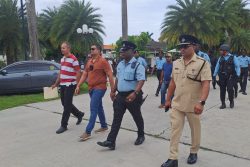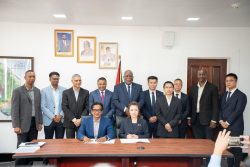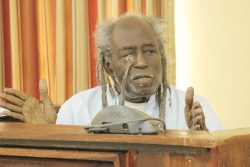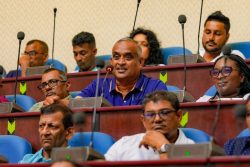Former Chief Executive Officer of NICIL, Winston Brassington will head government’s Gas-to- Shore Task Force (GSTF); a body that will report on the most viable options for the project, anticipated to start next year, Minister of Natural Resources Vickram Bharrat yesterday said.
Also on the team will be the National Procurement and Tender Administration Board Chairman Tarachand Balgobin.
“There are some other locals and we are looking to bring in some specialists because we will need that technical capacity, which we don’t really have in Guyana. We are trying to get some technical specialists to assist the team,” Bharrat added.
The PPP/C had campaigned on reducing electricity costs had said it will “hit the ground running to reduce power costs with natural gas”.
Shortly after being sworn in, and as he announced plans for the oil and gas sector, Vice President Bharrat Jagdeo reiterated the party’s position. He had also stated that his government has gathered that ExxonMobil was moving rapidly on the project but that the past APNU+AFC government had “put …roadblocks in this regard”.
“We have a couple of studies we are going through. We cannot look at what they didn’t do. We have to get it done and we want this done urgently. We have to be guided by the best technical minds but we want this project on the road as early as possible. In that engagement, we will have to get the cost that is very different than is in the contract. The contract locks in a price for the first 300-400 megawatts of power. We need the electricity to generate (power for) this country and fulfill the promise that we will cut their electricity bill. This is a project of high priority, we want to engage with Exxon…ExxonMobil is eager to move along and from what I gather is, they have been waiting for government to show interest”, Jagdeo had said.
But he added that environmental issues for all projects of the US oil major must be harnessed and government will “ensure that we have a commitment from ExxonMobil, because all of these issues are interlinked, a commitment that there will be adequate provisions for any environmental disaster, in the contract and by Exxon. We have to satisfy ourselves that that is so. Flaring [from oil extraction] is a key issue and we have to deal with that. We have already signalled that we don’t want flaring. We don’t want flaring,” he added.
‘Re-examine’
The Minister of Natural Resources also pointed to previous studies as he explained some of the Task Force’s duties.
“There were a few studies done before, they are going to re-examine those studies, they are going to look at possible locations to bring the pipeline to shore. Of course, they will give the government options and not tie us to one location only. They will give us possible locations and these will depend on how feasible it is to bring the line to shore and all of that and availability of land etcetera. Remember this pipeline is coming to shore so that we will have to set up a power plant to basically produce electricity from that natural gas. You need space to build that power plant. So in terms of land, we have to look at availability and how easy it will be to feed that power into the existing grid. These are some of the things they will be looking at as an immediate task,” Bharrat said as he explained that the area has to be at least 2000 acres with needed access and possibility for future expansion and development.
Government, according to the Natural Resources Minister, will also be engaging with Exxon throughout the project as the oil major’s support is “obviously needed” for project execution.
Fiscal terms will also be an area and the committee will analyze financial models to determine best options and will report this as an area in their findings.
“As for fiscal terms, we will work out that as we move along. Basically, we are just trying to, from all the studies that were done, put together a report for government to examine advising us of how we can move forward. The Committee will also look at financing models; that is whether we will do a PPP [Private Public Partnership] or the BOOT [Build, own, operate and transfer] system or whether government will fund it totally or whatever system. They will look at models and advise the government,” Bharrat said.
He added, “This is a project we are committed to, and as a matter of fact we are hoping we can start the actual project laying of pipelines from next year and maybe simultaneously build the power plant at the same time.”
Clonbrook
While identifying Clonbrook, Mahaica on the East Coast of Demerara, as the best location for bringing natural gas to shore for domestic use, a 2017 desk study done for the APNU+AFC government put the cost of doing this at US$304 million at least.
“The Clonbrook landing site is the optimal landing site for the 30 MMcfd [million cubic feet per day] pipeline,” the desk study of the “Options, Cost, Economics, Impacts, and Key Considerations of Transporting and Utilizing Natural Gas from Offshore Guyana for the Generation of Electricity”, United Kingdom company Energy Narrative, stated. It added that this option would cost US$304 million, including US$165 million, for the offshore pipeline, US$43.5 million for a compression station and separation plant onshore, and US$95.4 million for onshore pipelines to bring natural gas to power stations at Vreed-en-Hoop, Kingston, Garden of Eden, and Canefield.
Comparing the cost to seven other locations, the study notes, “The offshore pipeline is estimated to cost between US$165 million and US$270 million to build, depending on the size and landing site location. Onshore compression and separation of the LPG is estimated to cost between US$43 million and US$114 million. Finally, distributing the natural gas to the various electricity generation location is estimated to cost between US$95 million and $127 million for the various proposed landing sites.”










